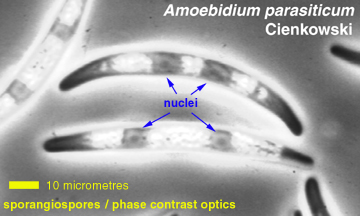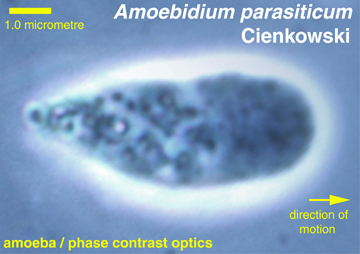
In nature, sporangiospore reproduction is usually associated with the reproduction of thalli on live hosts.
Amoebidium thalli reproduce asexually by producing either amoebae or walled sporangiospores. Diagram from Lichtwardt et al. 2001.

|
Sporangiospore reproduction. The parent thallus divides into a
number of walled nonmotile sporangiospores. Most sporangiospores
remain attached to the wall of the parent thallus, after it ruptures to
release the propagules. The shape and size of the sporangiospores varies
among the species. The sporangiospores are usually considered to be
uninucleate, though the examples illustrated are binucleate. The
sporangiospores are sticky at each end, attaching themselves to
insect/copepod exoskeletons and other substrates as they are
encountered. In nature, sporangiospore reproduction is usually associated with the reproduction of thalli on live hosts. |

|
Amoeboid reproduction. The parent thallus divides into, and releases, a number of small, naked, uninucleate, limax-type amoebae. After a period of gliding motility, the amoebae encyst. The cyst becomes multinucleate and eventually divides into a number of more or less elongate, pointed cystospores. The cystospores are released into the water column and adhere to substrate much as do the sporangiospores. |
Sexual reproduction has not been reliably observed.
Amoebidium: Index | Introduction | Appearance | Ultrastructure | Reproduction and Life History | Similar genera | Classification | Taxonomy and Nomenclature | Cultures | References | Internet resources
Protist Image Data: Picture Gallery | Home Page